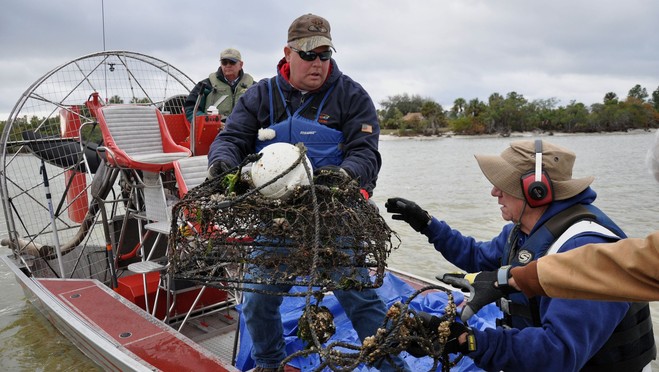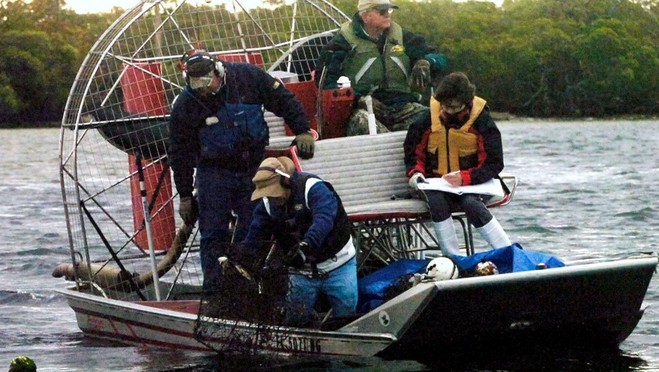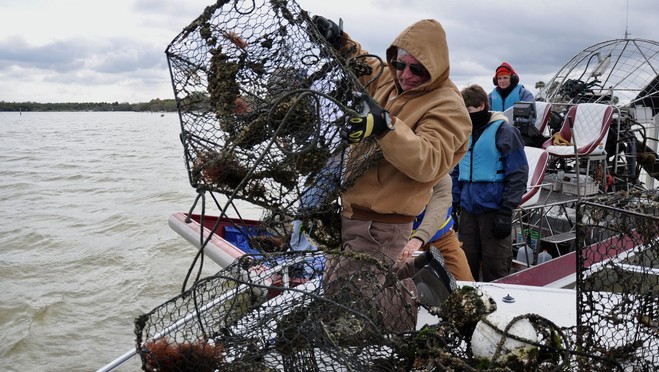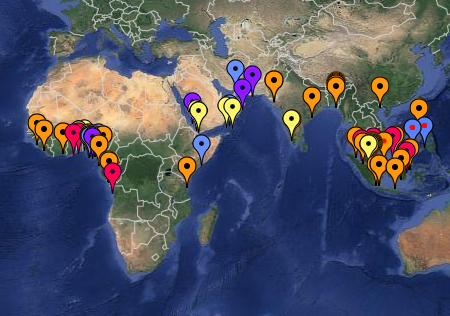12 airboats remove crab traps
By LOIS KINDLE | The Tampa Tribune
Published: January 26, 2011
Staff photo: JIM FARQUHAR
RUSKIN – More than 40 volunteers recently pulled some watery graves from the Little Manatee River, Wolf Branch and Cockroach Bay.

Dale North hands over a damaged crab trap found in the waters off South Shore to Gary Cunningham, as Tampa Bay Watch, Florida Airboat Association and community volunteers take part in an effort to remove crab traps from the Little Manatee River, Wolf Branch and Cockroach Bay Aquatic Preserve.
Sponsored by Tampa Bay Watch and supported by the Florida Airboat Association, the volunteers were part of an annual effort to keep derelict crab traps out of South Shore waters. This year’s effort brought in 35 traps.
“We try to do at least two of these every winter because of the extreme low tides during this time of year,” said Serra Herndon, habitat restoration director for Tampa Bay Watch. “The traps are easier to find since they are more exposed in the water.”
Herndon said with the help of volunteers, the nonprofit organization pulls abandoned, or derelict, traps because they “ghost” fish, meaning they continue catching crabs, fish and other marine life that are condemned to die in a cage that will never be harvested.
Blue crabs, stone crabs, small commercial and recreationally important fish, and brackish water turtles can also get caught in the traps. Manatees, dolphins and sea turtles may also become entangled in the trap line, causing injury or death. And the traps are considered marine debris, which create navigational hazards and damage boats, Herndon said.
“Occasionally, a trap is left behind intentionally,” Herndon said. “But 99 percent are lost to weather events, where the buoy and line gets detached from the traps.”
This year, 12 airboats carrying three to four people each, including a captain, a trap puller and data entry clerk, headed out from the E.G. Simmons boat ramp to spend several hours collecting traps. Once brought to shore, the traps are destroyed and taken to a landfill.
“We might have found a few more,” Herndon said, “but the weather wasn’t cooperating. The wind was gusting up to 30 knots, which is way too high for the airboats to operate safely. We had to come in an hour earlier than usual.”

Gary Cunningham of the Florida Airboat Association checks out a crab trap to see if it is legal. The trap had the proper identification on it and was left intact.
The volunteers were briefed before leaving shore and provided a list of valid license holders to ensure only illegal traps were collected, using strict criteria established by the Florida Fish & Wildlife Conservation Commission. Legal traps must have three of the following, Herndon said: six intact sides, a buoy, line, current crab trap ID and valid commercial saltwater products license. Anything less and traps are considered derelict.
There are estimates that thousands of derelict crab traps have been accumulating for decades in Tampa Bay, Herndon said.
Each year, Tampa Bay Watch performs surveys to find, identify and then conduct cleanups for removal. Including the Jan. 22 effort at E.G. Simmons Park, the group has completed 16 crab trap removals since May 2004 and removed more than 700 traps from the bay.
This year’s event was sponsored in part by Streamline Environmental, NOAA Fisheries and Restore America’s Estuaries.



